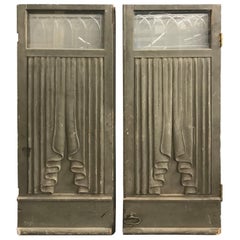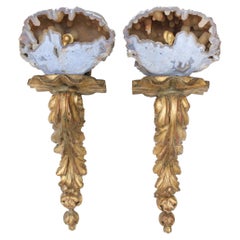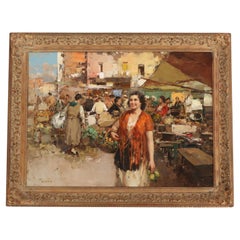Hand-Carved Decorative Art
Late 19th Century English Victorian Antique Hand-Carved Decorative Art
Glass, Wood
1770s American American Colonial Antique Hand-Carved Decorative Art
Gold Leaf
2010s South African Hand-Carved Decorative Art
Ceramic
1830s French Napoleon III Antique Hand-Carved Decorative Art
Glass, Wood, Giltwood
18th Century Irish Rococo Antique Hand-Carved Decorative Art
Agate, Coral, Gold Leaf
Late 19th Century Italian Other Antique Hand-Carved Decorative Art
Gesso, Canvas, Giltwood, Paint
Mid-18th Century Italian Baroque Antique Hand-Carved Decorative Art
Fruitwood
18th Century French Rococo Antique Hand-Carved Decorative Art
Canvas, Wood, Giltwood, Paint
Early 19th Century Antique Hand-Carved Decorative Art
Walnut
19th Century British Folk Art Antique Hand-Carved Decorative Art
Wood
Early 19th Century German Biedermeier Antique Hand-Carved Decorative Art
Wood
16th Century Italian Renaissance Antique Hand-Carved Decorative Art
Walnut
19th Century German Louis XVI Antique Hand-Carved Decorative Art
Porcelain, Giltwood
18th Century French Classical Roman Antique Hand-Carved Decorative Art
Oak
18th Century Italian Baroque Antique Hand-Carved Decorative Art
Gold Leaf
19th Century Italian Renaissance Antique Hand-Carved Decorative Art
Wood, Paint
17th Century Italian Renaissance Antique Hand-Carved Decorative Art
Canvas, Plaster, Wood, Giltwood
Early 20th Century American Hand-Carved Decorative Art
Canvas, Wood
19th Century European Antique Hand-Carved Decorative Art
Metal
2010s European Modern Hand-Carved Decorative Art
Marble, Bronze
1860s English William IV Antique Hand-Carved Decorative Art
Canvas, Wood, Giltwood, Paint
Late 18th Century English Antique Hand-Carved Decorative Art
Glass, Wood, Paper
Late 18th Century French Beaux Arts Antique Hand-Carved Decorative Art
Fruitwood
18th Century Italian Renaissance Revival Antique Hand-Carved Decorative Art
Mirror, Oak
1870s Italian Grand Tour Antique Hand-Carved Decorative Art
Marble, Porphyry, Ormolu
1890s French Louis XVI Antique Hand-Carved Decorative Art
Bronze
20th Century Congolese Primitive Hand-Carved Decorative Art
Wood
20th Century Congolese Primitive Hand-Carved Decorative Art
Wood
1950s American Mid-Century Modern Vintage Hand-Carved Decorative Art
Rattan, Wood
18th Century Japanese Edo Antique Hand-Carved Decorative Art
Metal, Iron
2010s North American Bauhaus Hand-Carved Decorative Art
Walnut
21st Century and Contemporary Turkish Modern Hand-Carved Decorative Art
Resin, Wood, Walnut
Early 20th Century Chinese Hand-Carved Decorative Art
Teak
Late 19th Century Italian Medieval Antique Hand-Carved Decorative Art
Wood
17th Century Belgian Antique Hand-Carved Decorative Art
Oak, Paint
19th Century French Japonisme Antique Hand-Carved Decorative Art
Multi-gemstone
Late 19th Century French Medieval Antique Hand-Carved Decorative Art
Wood
Late 19th Century Italian Antique Hand-Carved Decorative Art
Terracotta, Wood, Walnut
1820s Japanese Japonisme Antique Hand-Carved Decorative Art
Wood
21st Century and Contemporary European Rustic Hand-Carved Decorative Art
Metal
18th Century Portuguese Baroque Antique Hand-Carved Decorative Art
Wood
18th Century French Antique Hand-Carved Decorative Art
Wood
19th Century Russian Antique Hand-Carved Decorative Art
Canvas, Wood
Late 19th Century Japanese Japonisme Antique Hand-Carved Decorative Art
Shell, Bone, Mother-of-Pearl, Lacquer
19th Century Japanese Meiji Antique Hand-Carved Decorative Art
Metal, Brass, Bronze, Iron
Mid-18th Century Italian Rococo Antique Hand-Carved Decorative Art
Poplar
Mid-19th Century Italian Early Victorian Antique Hand-Carved Decorative Art
Wood
19th Century Japanese Meiji Antique Hand-Carved Decorative Art
Wood
1940s German Romantic Vintage Hand-Carved Decorative Art
Wool, Wood
Early 20th Century French Baroque Hand-Carved Decorative Art
Metal
1930s Swiss Expressionist Vintage Hand-Carved Decorative Art
Wood
1950s Austrian Mid-Century Modern Vintage Hand-Carved Decorative Art
Brass
20th Century American Tribal Hand-Carved Decorative Art
Wood, Paint
19th Century Italian Antique Hand-Carved Decorative Art
Pine
Mid-20th Century European Art Deco Hand-Carved Decorative Art
Alabaster, Iron
Late 18th Century French Empire Antique Hand-Carved Decorative Art
Mirror, Giltwood
16th Century Belgian Gothic Antique Hand-Carved Decorative Art
Oak
Late 19th Century Italian Antique Hand-Carved Decorative Art
Marble
Early 19th Century Italian Neoclassical Antique Hand-Carved Decorative Art
Wood
Late 20th Century Mexican Arts and Crafts Hand-Carved Decorative Art
Leather, Wood, Paper
Read More
At Colonial Williamsburg, Everything Old Is New Again
With the help of a new director, the Virginia institution's folk art and decorative arts museums are undergoing extensive upgrades.
New York’s Hirschl & Adler Showcases the American Workmanship and Design Panache of Neoclassical Treasures
The gallery's latest exhibition proves that museum-quality pieces entice and inspire, whether in traditional or more modern interiors.





